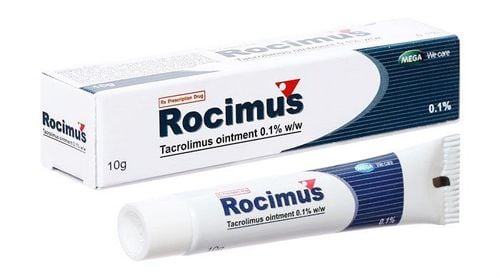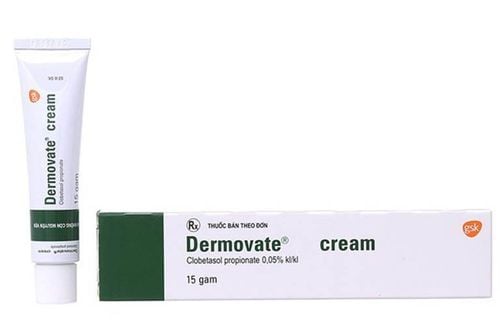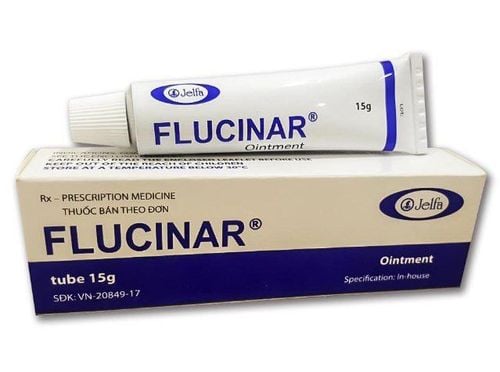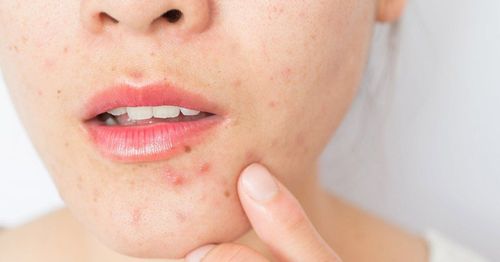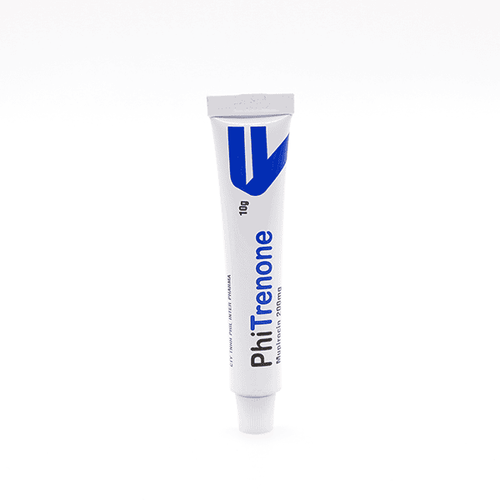This is an automatically translated article.
Flucinar 15g drug is made in the form of an ointment commonly used to overcome a number of skin diseases. It is necessary to know the information about the drug in order to use it properly, to avoid adverse problems arising. To better understand Flucinar, the use of Flucinar 15g, let's learn more in the article below.1. What is Flucinar?
Flucinar has the main ingredient Fluocinolone, which belongs to the group of drugs that are fungicides and parasites for topical use. The drug is prepared in the form of 15 grams of topical ointment, manufactured by Pharmaceuticals Works Jelfa S.a - Poland.The drug is often used in cases of symptomatic treatment of dermatological diseases including:
Allergic dermatitis, seborrhea. Erythema multiforme, urticaria associated with Liken disease, perennial psoriasis. Glucocorticosteroid-responsive non-infectious atopic dermatitis, accompanied by keratosis or persistent pruritus. Lupus erythematosus, Eczema due to contact allergy, lichen planus.
2. Uses of Flucinar 15g
2.1. Pharmacodynamics of Flucinar 15g
Fluocinolone acetonide is a synthetic corticosteroid of low to moderate potency, with a fluorine atom attached to the steroid nucleus. The mechanism of action of a topical corticosteroid is due to a combination of three important properties: antipruritic, anti-inflammatory, and vasoconstrictor action.Corticosteroids reduce the release, formation and limit the effect of vasoconstrictor substances released during inflammation (histamines, kinins, Iysosomal enzymes, leukotrienes, prostaglandins and complement components). ) thereby helping to reduce inflammation. Steroids also reduce the permeability of cell membranes. Due to their vasoconstriction effects, fluocinolones help reduce fluid leakage in the inflamed skin. The drug increases collagen accumulation and protein synthesis, slows down the proliferative processes and promotes protein breakdown in the skin.
Corticosteroids, especially fluorinated corticosteroids, act against the mitotic activity of the top layer epidermal cells. Repeated use of fluoride-containing corticosteroids reduces the effect of the drug on the surface of the skin, which leads to a longer time for the drug to take effect, but increases the undesirable effects and also increases absorption. Body.
2.2. Pharmacokinetics of the drug Flucinar 15g
Absorption: When topical corticosteroids are applied to undamaged skin, only small amounts reach the dermis and then the general circulation. However, drug absorption is significantly increased when the skin loses its keratin layer, due to inflammation and/or other diseases of the epidermal barrier (eczema, psoriasis). Depending on the degree of penetration, the amount of drug applied on thick or thin skin and the condition of the skin at the application site, the amount of drug absorbed also varies. Specifically: The drug is absorbed more in the eyelids (about 40%) and scrotum (about 36%) than the forehead (about 7%), scalp (about 4%) or forearms (about 1%). The drug is also absorbed more in areas where the skin is folded. Fluocinolone acetonide easily penetrates the stratum corneum of the skin at the site where the drug is accumulated. Accumulation of the drug can be found at that site 15 days after application.Metabolism: Fluocinolone acetonide in Flucinar ointment is not metabolised in the skin. When the drug is applied according to the instructions for use, a small amount of the tuber is absorbed into the systemic circulation and is metabolized in the liver to inactive substances.
Elimination: The drug is eliminated mainly by the kidneys as glucuronide and sulfate, as well as as unconjugated. Small amounts of metabolites are excreted in the feces.
2.3. Contraindications of the drug Flucinar 15g
Flucinar 15g should not be used in the following cases:Hypersensitivity to any ingredient of the drug. Skin is infected with bacteria, fungi, viruses. Folliculitis, perioral dermatitis, rosacea. After vaccination. Children under 2 years old. Use caution when using for subcutaneous tissue atrophy, especially the elderly.
2.4. Side effects of the drug Flucinar 15g
On the skin Acne or pimples. Accumulation of pus. Irritation, itching, blistering, scaling, or redness of the skin. Itching, pain, and burning in hairy or pus-filled skin areas. Itchy skin with red blisters that are as small as needles. Dry, cracked skin. Skin is darker than usual. Severe redness, itching, scaling, or soreness or swelling of the skin. The bumps are itchy, raised above the surface of the skin, round, smooth, skin-colored and found only on certain areas of the body. Small raised, dark red, wart-like spots on the skin, especially when the medication is used on the face. Hearing: Change in hearing, ear pain or pain in the ear Sight: Using Flucinar ointment on the skin of the eyelids can sometimes cause cataracts or glaucoma. Systemic:: Cushing's syndrome, hypothalamic-pituitary-adrenal axis suppression, hypertension, hyperglycemia, edema, immunosuppression.2.5. Precautions while using Flucinar 15g
If you notice symptoms of skin irritation or allergic reactions appear after applying Flucinar ointment, it should be discontinued. Avoid using the drug continuously for more than 14 days. Long-term use of the drug over large areas of the skin may increase the frequency of side effects, possibly causing edema, hyperglycemia (increased blood glucose levels), increased blood pressure, and decreased immunity. Systemic absorption of topical corticosteroids produced reversible suppression of the hypothalamic-pituitary-adrenal (HPA) axis, manifestations of hyperglycemia, Cushing's syndrome, and glucoseuria in one patient. number of patients. Conditions that increase systemic drug absorption include use of stronger steroids, prolonged use of the drug, application of the drug over large surface areas, and wound dressings. Therefore, patients who receive a large dose of topical steroid with a large surface area or are covered with an embolized occlusive dressing should be evaluated at regular intervals for evidence of HPA axis suppression using the test. Urinalysis for stimulation of free cortisol and ACTH. If HPA axis suppression is noted, efforts should be made to reduce the drug, reduce its frequency of use, or replace it with a lower-level steroid. Recovery of HPA axis function is usually rapid and complete after drug discontinuation. In the event of increased infection at the site of ointment application, treatment with appropriate antifungal and antibacterial agents should be instituted. If the symptoms of infection persist, the topical application should be discontinued until the infection clears up. Care should be taken when applying Flucinar not to get into eyes, mucous membranes or open wounds. Avoid use of the drug in the eyelid area or the skin near the eyelid in patients with wide-angle and narrow-angle glaucoma, and also in patients with cataracts because it may increase the clinical symptoms of the disease. Use with particular caution in patients with psoriasis because topical use of corticosteroids can be dangerous for a number of reasons, including relapse due to increased tolerance that occurs in common pustular psoriasis and infections. systemic toxicity due to skin imperfections. Only use the drug on the skin of the face, armpits and groin when absolutely necessary because of increased absorption and the risk of unwanted effects (capillary dilation, perioral dermatitis) even after use for a period of time. short. Use with caution in cases of subcutaneous tissue atrophy, especially in elderly patients. Flucinar ointment contains the excipient propylene glycol which may be the cause of allergic reactions. Therefore, patients with a history of allergy to propylene glycol should consult their doctor or pharmacist before using the drug. Patients should not arbitrarily cover or cover the diseased skin after using the drug, unless directed by a specialist. The drug should not be covered with a bandage when using the drug on a large area of skin because this will increase the patient's likelihood of systemic toxicity. Pregnant and lactating women should not take the drug unless prescribed by a specialist. Children and Adolescents: Children may be at increased risk of hypothalamic-pituitary-adrenal axis disorders and Cushing's syndrome due to the systemic effects of corticosteroids and a greater incidence of skin surface defects in children than in adults. body mass ratio. Long-term treatment with corticosteroids can disrupt growth and development in children.2.6. Drug interactions
No interactions have been reported with topical use. However, chickenpox vaccine and other immunotherapy drugs should not be given due to a decrease in the large-scale response due to the decrease, especially when applying the drug on a large scale.To ensure safety and effectiveness, tell your doctor about all medications, health foods you are taking and other medical conditions you have to prevent adverse interactions from occurring.
3. How to use Flucinar 15g effectively
Use Flucinar correctly:Wash your hands with soap and water before and after using fluocinolone. It is very important that you only use fluocinolone exactly as directed by your doctor. Do not apply thicker layers, do not use the medicine as often, and do not use the medicine longer than prescribed by your doctor. Doing so may cause unwanted side effects or irritate the skin. The use of the drug should be adjusted based on the severity and nature of the different diseases as well as the sensitivity of the individual patient. Fluocinolone should not be used to treat certain types of skin infections or conditions, such as severe burns. Only apply a small amount of medicine to the surface of the infected skin, do not spread around, do not apply more than 1-2 times / day. Remember not to cover the area of application without a doctor's order; Except in the case of psoriasis, a dressing may be required and the dressing should be changed daily. Use on the face: No more than 7 days. Do not use more than 1 tube of Flucinar ointment 15 grams per week. Children and adolescents: Do not use in children under 2 years of age. Caution should be exercised when using the drug in children over 2 years of age. Only use the medicine when absolutely necessary, once a day and do not use it on children's face. If the medication is used on an infant's diaper area, do not use diapers or tights unless directed by your doctor.
Please dial HOTLINE for more information or register for an appointment HERE. Download MyVinmec app to make appointments faster and to manage your bookings easily.




